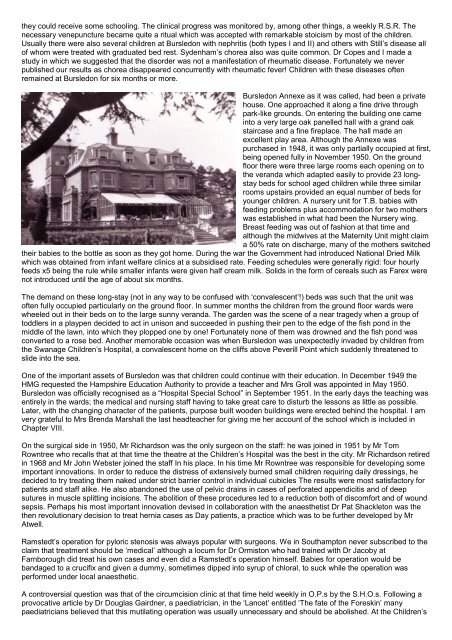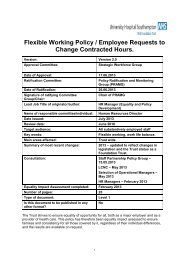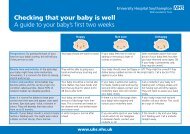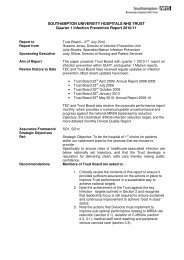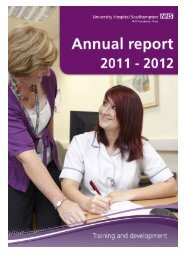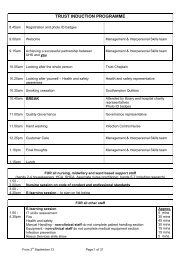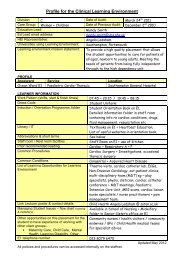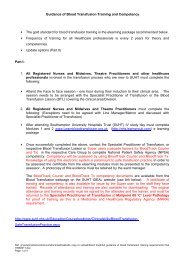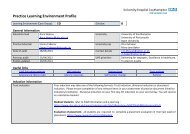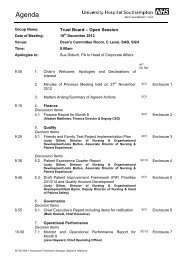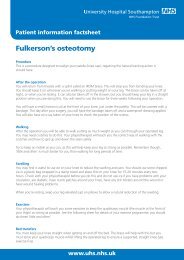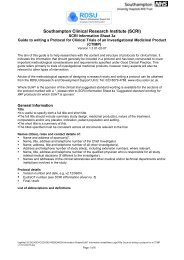ninety years of service - University Hospital Southampton NHS ...
ninety years of service - University Hospital Southampton NHS ...
ninety years of service - University Hospital Southampton NHS ...
- No tags were found...
You also want an ePaper? Increase the reach of your titles
YUMPU automatically turns print PDFs into web optimized ePapers that Google loves.
they could receive some schooling. The clinical progress was monitored by, among other things, a weekly R.S.R. Thenecessary venepuncture became quite a ritual which was accepted with remarkable stoicism by most <strong>of</strong> the children.Usually there were also several children at Bursledon with nephritis (both types I and II) and others with Still’s disease all<strong>of</strong> whom were treated with graduated bed rest. Sydenham’s chorea also was quite common. Dr Copes and I made astudy in which we suggested that the disorder was not a manifestation <strong>of</strong> rheumatic disease. Fortunately we neverpublished our results as chorea disappeared concurrently with rheumatic fever! Children with these diseases <strong>of</strong>tenremained at Bursledon for six months or more.Bursledon Annexe as it was called, had been a privatehouse. One approached it along a fine drive throughpark-like grounds. On entering the building one cameinto a very large oak panelled hall with a grand oakstaircase and a fine fireplace. The hall made anexcellent play area. Although the Annexe waspurchased in 1948, it was only partially occupied at first,being opened fully in November 1950. On the groundfloor there were three large rooms each opening on tothe veranda which adapted easily to provide 23 longstaybeds for school aged children while three similarrooms upstairs provided an equal number <strong>of</strong> beds foryounger children. A nursery unit for T.B. babies withfeeding problems plus accommodation for two motherswas established in what had been the Nursery wing.Breast feeding was out <strong>of</strong> fashion at that time andalthough the midwives at the Maternity Unit might claima 50% rate on discharge, many <strong>of</strong> the mothers switchedtheir babies to the bottle as soon as they got home. During the war the Government had introduced National Dried Milkwhich was obtained from infant welfare clinics at a subsidised rate. Feeding schedules were generally rigid: four hourlyfeeds x5 being the rule while smaller infants were given half cream milk. Solids in the form <strong>of</strong> cereals such as Farex werenot introduced until the age <strong>of</strong> about six months.The demand on these long-stay (not in any way to be confused with ‘convalescent’!) beds was such that the unit was<strong>of</strong>ten fully occupied particularly on the ground floor. In summer months the children from the ground floor wards werewheeled out in their beds on to the large sunny veranda. The garden was the scene <strong>of</strong> a near tragedy when a group <strong>of</strong>toddlers in a playpen decided to act in unison and succeeded in pushing their pen to the edge <strong>of</strong> the fish pond in themiddle <strong>of</strong> the lawn, into which they plopped one by one! Fortunately none <strong>of</strong> them was drowned and the fish pond wasconverted to a rose bed. Another memorable occasion was when Bursledon was unexpectedly invaded by children fromthe Swanage Children’s <strong>Hospital</strong>, a convalescent home on the cliffs above Peverill Point which suddenly threatened toslide into the sea.One <strong>of</strong> the important assets <strong>of</strong> Bursledon was that children could continue with their education. In December 1949 theHMG requested the Hampshire Education Authority to provide a teacher and Mrs Groll was appointed in May 1950.Bursledon was <strong>of</strong>ficially recognised as a “<strong>Hospital</strong> Special School” in September 1951. In the early days the teaching wasentirely in the wards; the medical and nursing staff having to take great care to disturb the lessons as little as possible.Later, with the changing character <strong>of</strong> the patients, purpose built wooden buildings were erected behind the hospital. I amvery grateful to Mrs Brenda Marshall the last headteacher for giving me her account <strong>of</strong> the school which is included inChapter VIII.On the surgical side in 1950, Mr Richardson was the only surgeon on the staff: he was joined in 1951 by Mr TomRowntree who recalls that at that time the theatre at the Children’s <strong>Hospital</strong> was the best in the city. Mr Richardson retiredin 1968 and Mr John Webster joined the staff In his place. In his time Mr Rowntree was responsible for developing someimportant innovations. In order to reduce the distress <strong>of</strong> extensively burned small children requiring daily dressings, hedecided to try treating them naked under strict barrier control in individual cubicles The results were most satisfactory forpatients and staff alike. He also abandoned the use <strong>of</strong> pelvic drains in cases <strong>of</strong> perforated appendicitis and <strong>of</strong> deepsutures in muscle splitting incisions. The abolition <strong>of</strong> these procedures led to a reduction both <strong>of</strong> discomfort and <strong>of</strong> woundsepsis. Perhaps his most important innovation devised in collaboration with the anaesthetist Dr Pat Shackleton was thethen revolutionary decision to treat hernia cases as Day patients, a practice which was to be further developed by MrAtwell.Ramstedt’s operation for pyloric stenosis was always popular with surgeons. We in <strong>Southampton</strong> never subscribed to theclaim that treatment should be ‘medical’ although a locum for Dr Ormiston who had trained with Dr Jacoby atFarnborough did treat his own cases and even did a Ramstedt’s operation himself. Babies for operation would bebandaged to a crucifix and given a dummy, sometimes dipped into syrup <strong>of</strong> chloral, to suck while the operation wasperformed under local anaesthetic.A controversial question was that <strong>of</strong> the circumcision clinic at that time held weekly in O.P.s by the S.H.O.s. Following aprovocative article by Dr Douglas Gairdner, a paediatrician, in the ‘Lancet’ entitled ‘The fate <strong>of</strong> the Foreskin’ manypaediatricians believed that this mutilating operation was usually unnecessary and should be abolished. At the Children’s


